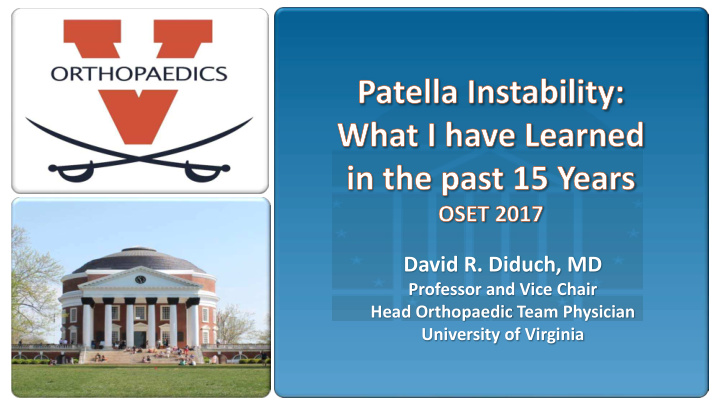



David R. Diduch, MD Professor and Vice Chair Head Orthopaedic Team Physician University of Virginia
Financial Disclosure David Diduch The following relationships with commercial interests related to this presentation existed during the past 12 months: Institutional grant and research support – Zimmer, Genzyme, Aesculap Consultant – Depuy Mitek Royalties – Smith and Nephew University of Virginia Orthopaedic Surgery
MPFL is key structure • 60% of restraining force University of Virginia Orthopaedic Surgery University of Virginia Orthopaedic Surgery
PROXIMAL REALIGNMENT advance medial structures Stretches out with time Does not restore anatomy
Tightening or advancement ….MPFL not anchored if torn from femur University of Virginia Orthopaedic Surgery
MPFL Primary Repair University of Virginia Orthopaedic Surgery
Not precise – easy to get it wrong University of Virginia Orthopaedic Surgery
Use a GRAFT • Strong, reliable, predictable – MPFL mean tensile strength 218N – Gracilis 350N – 550N • Noyes 1984; Hamner 1999 – Allows anatomic positioning and fixation – WHERE TO PUT IT IS THE KEY University of Virginia Orthopaedic Surgery
Patella fixation with anchors or tunnels University of Virginia Orthopaedic Surgery
MPFL Reconstruction E. Arendt
MEDIAL C B A MFC MCL
Schottle’s Point - get femoral location right! • More reproducible and precise with X-Ray University of Virginia Orthopaedic Surgery
Get a Perfect lateral. Pin doesn’t move. C A B University of Virginia Orthopaedic Surgery
Check length through full ROM University of Virginia Orthopaedic Surgery
Proximal is worst mistake
Fixing at > 45 magnifies poor placement
Troubleshooting – as knee flexes: University of Virginia Orthopaedic Surgery
Graft tensioning • Set at 30 – 45° of knee flexion • Patella engaged in trochlea • Only ½ pound (2N) • NOT an ACL graft • Overtensioning – Easiest mistake – Chondrosis – Loss of flexion – Graft rupture – Medial instability University of Virginia Orthopaedic Surgery
What about alignment? TT-TG has replaced the Q angle Tibial tubercle – trochlear groove distance in mm > 20 mm abnormal. Goal 10 post op Schottle, Knee 13, 2006, 26-31. University of Virginia Orthopaedic Surgery
Fulkerson AMZ Osteotomy • Consider if TT-TG > 20 • AND lateral tracking, tilt • Especially if combined with alta • Not an absolute number
Tendon draped over condyle University of Virginia Orthopaedic Surgery
The “J” sign – Why? • Patella leaves the bony restraint of the groove in full extension. Either • Patella Alta • Dysplasia with spur • Or both University of Virginia Orthopaedic Surgery University of Virginia Orthopaedic Surgery
Step Cut for large corrections Tubercle moved distally University of Virginia Orthopaedic Surgery
Can also “feather” and slide 4-5 mm University of Virginia Orthopaedic Surgery University of Virginia Orthopaedic Surgery
Decision Making – MPFL reconstruction “always” – Fulkerson if TT-TG > 20 and lateral tracking – Lateral release only if needed – do last – If “J sign” and very unstable, possibly • Trochlear dysplasia, or • Patella alta – Move distal if CD ratio > 1.4 University of Virginia Orthopaedic Surgery
Trochlear Dysplasia Supratrochlear Spur – “bump” University of Virginia Orthopaedic Surgery University of Virginia Orthopaedic Surgery
Thank you University of Virginia Orthopaedic Surgery
Recommend
More recommend